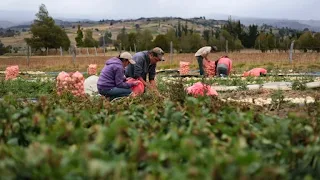Farms Without Farmers
From autonomous tractors to AI-powered irrigation systems, the technological shift in agriculture is accelerating. According to a 2023 report by McKinsey & Company, automation could perform up to 70% of agricultural tasks within the next two decades.
“We’re seeing an unprecedented transformation in farming,” said Dr. Ramesh Krishnan, an agricultural robotics researcher at Wageningen University. “Robots can now identify ripe fruit, avoid obstacles, and harvest more consistently than most humans.”
The Technology Driving the Change
Companies like John Deere and startup Carbon Robotics are at the forefront of this revolution. Deere’s autonomous 8R tractor, launched in 2022, can be operated remotely through a smartphone app, while Carbon Robotics has developed AI-driven weeders that eliminate the need for herbicides.
Meanwhile, drones and satellite imaging provide farmers with real-time data on crop health and soil conditions, enabling precision agriculture on a scale never before possible.
Benefits and Promises
Proponents argue that automation addresses multiple crises in the agricultural sector: labor shortages, climate variability, and sustainability demands. The U.S. Department of Agriculture (USDA) has noted that automation can reduce pesticide use, conserve water, and increase yields.
“With climate change affecting growing seasons and fewer people choosing to work in agriculture, automation isn’t a luxury — it’s a necessity,” said Teresa Mills, policy analyst at the USDA.
The Human Cost
Yet the transition is not without consequence. In rural regions, the rise of machines could displace millions of farm workers. A 2024 study by the International Labour Organization (ILO) warned that automation may exacerbate inequality unless policies are enacted to support displaced workers.
“This is not just a technological shift. It’s a social one,” said Marco Duarte, a labor economist at the ILO. “Without retraining programs and safety nets, entire communities could be left behind.” ILO
What Lies Ahead
As automation spreads from industrial farms to smaller operations, governments and institutions face tough questions: How can technology serve both efficiency and equity? Should there be limits to machine-led agriculture?
Experts agree that the sector's future will likely include both machines and humans — but the balance is shifting. “Automation will redefine the farmer's role,” said Dr. Krishnan. “It won’t eliminate humans, but it will demand new skills and a very different type of labor.”
Conclusion
The age of automated agriculture is already here. While the machines promise higher productivity and resilience, the impact on livelihoods, rural economies, and food systems remains uncertain. As fields become increasingly digital, the biggest challenge may not be technical — but human.



Comments
Post a Comment
Leave a comment. Thanks!
Comentarios de Facebook